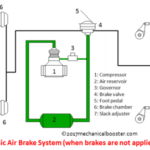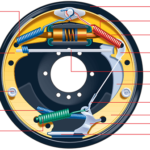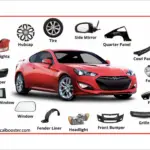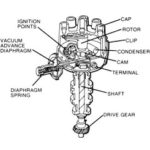Brakes are very crucial for stopping a vehicle. Without brakes, it is impossible to drive a car or any vehicle. Brakes are of different types and according to the requirement, the types of brakes are chosen for the application. Here we will discuss Disc brake – its main components, working, advantages, and disadvantages with the application.
Main Components of Disc Brake

Image source
1. Wheel Hub:
The disc rotor is attached to the wheel hub and it rotates with it. The wheel of the vehicle is bolted to the wheel hub.
2. Caliper Assembly:
The caliper assembly consists of
(i) Brake pad: It makes contact with the rotor disc and due to the friction between the brake pad and rotor disc the vehicle speed reduces and it stops.
(ii) Caliper bracket
(iii) Caliper frame
(iv) Piston: It applies the brake force on the brake pads when brake lever is pressed.
(v) Slider pin: It is the sliding pin which slides in the hole when brake is applied.
(vi) Dust boots: It prevents the entry of dust into the caliper pin or slider pin hole.
3. Disc Rotor:
It is the rotating part of disc brake. When brakes are applied, a lot of heat is generated which can decrease the braking efficiency, so the rotor has drilled vent holes on it which dissipates the heat.
Also Read:
- Drum Brakes vs Disc Brakes – Which is Better?
- How Drum Brakes Work?- Easiest Explanation Ever
- How Air Brake System Works in Automobile?
Working Principle
The working of a disc brake is based on Pascal law.
Working of Disc Brakes

- When the brake pedal is pressed, the high pressure fluid from the master cylinder pushes the piston outward.
- The piston pushes the brake pad against the rotating disc.
- As the inner brake pad touches rotor, the fluid pressure exerts further force and the caliper moves inward and pulls the outward brake pad towards the rotating disc and it touches the disc.
- Now both the brake pads are pushes the rotating disc, a large amount of friction is generated in between the pads and rotating disc and slows down the vehicle and finally makes it stop.
- When the brake pad is released, the piston moves inward, the brake pad moves away from the rotating disc. And the vehicle again starts to move.
For a better explanation of how disc brake works, watch the video given below:
Advantages
- It is lighter than drum brakes.
- It has better cooling ( because the braking surface is directly exposed to the air)
- It offers better resistance to fade.
- It provides uniform pressure distribution
- The replacement of brake pads are easy.
- By design, they are self-adjusting brakes.
Disadvantages
- It is costlier than drum brakes.
- Higher pedal pressure is required for stopping the vehicle. This brake system is installed with a vacuum booster.
- No servo action is present.
- It is difficult to attach a suitable parking attachment.
Application
- Disc brakes are mostly used in motorcycles and cars.
Conclusion
Here we have discussed How Disc Brakes Work, their main parts, working principles, advantages, and disadvantages with application. I hope you have understood everything clearly and if you found this piece of information useful and valuable then don’t forget to like and share it.








Thanks to Mechanical booster for providing much matter about Auto Mobile